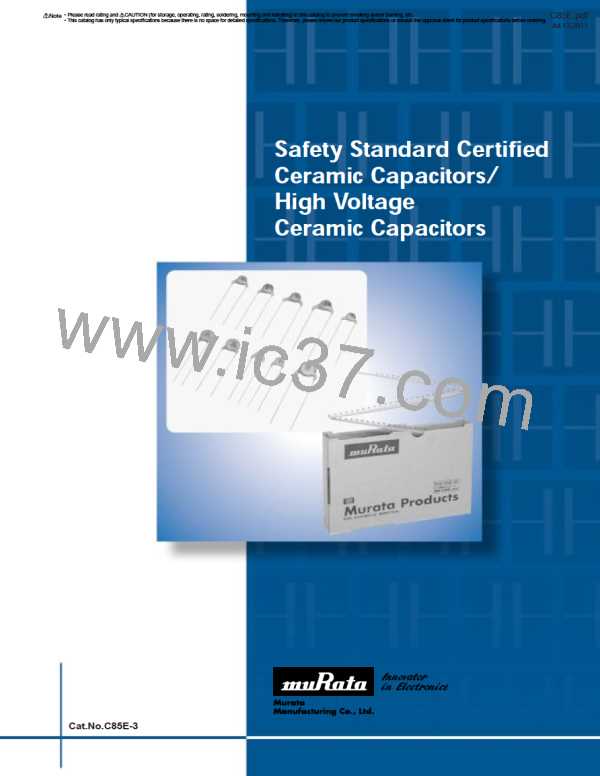• Please read rating and !CAUTION (for storage, operating, rating, soldering, mounting and handling) in this catalog to prevent smoking and/or burning, etc.
• This catalog has only typical specifications because there is no space for detailed specifications. Therefore, please review our product specifications or consult the approval sheet for product specifications before ordering.
!Note
C85E.pdf
Jul.13,2011
DEJ Series (Which Meet Japanese Law)
DEJ Series Specifications and Test Methods
Continued from the preceding page.
No.
Item
Appearance
I.R.
Specifications
Test Method
No marked defect
As shown in the figure, the lead
Capacitor
1.5
Thermal
Screen
wires should be immersed in
solder of 350±10˚C up to 1.5 to
2.0mm from the root of terminal for
3.5±0.5 sec.
1000MΩ min.
to 2.0mm
Molten
Solder
Soldering
10 Effect
Pre-treatment:
(Non-Preheat) Dielectric
Strength
Capacitor should be stored at 85±2˚C for 1 hr., then placed at
room condition*1 for 24±2 hrs. before initial measurements.
Post-treatment:
Per Item 6
Capacitor should be stored for 4 to 24 hrs. at room
condition.*1
Appearance
I.R.
No marked defect
First the capacitor should be
stored at 120+0/-5°C for
60+0/-5 sec.
Then, as in the figure, the lead
wires should be immersed in
solder of 260+0/-5°C up to 1.5 to
2.0mm from the root of terminal
for 7.5+0/-1 sec.
Capacitor
1.5
Thermal
Screen
1000MΩ min.
to 2.0mm
Molten
Solder
5
Soldering
11 Effect
(On-Preheat)
Dielectric
Strength
Per Item 6
Pre-treatment:
Capacitor should be stored at 85±2˚C for 1 hr., then placed at
room condition*1 for 24±2 hrs. before initial measurements.
Post-treatment:
Capacitor should be stored for 4 to 24 hrs. at
room condition.*1
Appearance
Capacitance
No marked defect
The capacitor should be firmly soldered to the supporting lead
wire and vibrated at a frequency range of 10 to 55Hz, 1.5mm in
total amplitude, with about a 1-minute rate of vibration change
from 10Hz to 55Hz and back to 10Hz.
Within the specified tolerance
Vibration
Resistance
12
13
Char.
Specifications
D.F.
E
F
D.F.V2.5%
D.F.V5.0%
Apply for a total of 6 hrs., 2 hrs. each in 3 mutually perpendicular
directions.
Solvent
Resistance
The capacitor should be immersed into a isopropyl alcohol for
30±5 sec.
Appearance
Appearance
No marked defect
No marked defect
Char.
E
F
Capacitance Change
Within ±20%
Capacitance
Change
Set the capacitor for 500±12 hrs. at 40±2˚C in 90 to 95%
relative humidity.
Pre-treatment:
Within ±30%
Humidity
(Under
Steady
State)
14
Char.
E
F
Specifications
D.F.V5.0%
D.F.V7.5%
Capacitor should be stored at 85±2˚C for 1 hr., then placed at
room condition*1 for 24±2 hrs. before initial measurements.
Post-treatment:
D.F.
I.R.
Capacitor should be stored for 1 to 2 hrs. at room condition.*1
1000MΩ min.
Per Item 6
Dielectric
Strength
Appearance
No marked defect
Char.
E
F
Capacitance Change
Within ±20%
Capacitance
Change
The capacitor should be subjected to 40±2˚C, relative humidity
of 90 to 98% for 8 hrs., and then removed in room temperature
for 16 hrs. until 5 cycles are completed.
Within ±30%
Humidity
Insulation
Pre-treatment:
15
Char.
E
F
Specifications
D.F.V5.0%
D.F.V7.5%
Capacitor should be stored at 85±2˚C for 1 hr., then placed at
room condition*1 for 24±2 hrs. before initial measurements.
Post-treatment:
D.F.
I.R.
Capacitor should be stored for 1 to 2 hrs. at room condition.*1
1000MΩ min.
Dielectric
Strength
Per Item 6
*1 "Room condition" Temperature: 15 to 35°C, Relative humidity: 45 to 75%, Atmospheric pressure: 86 to 106kPa
Continued on the following page.
19

 MURATA [ muRata ]
MURATA [ muRata ]